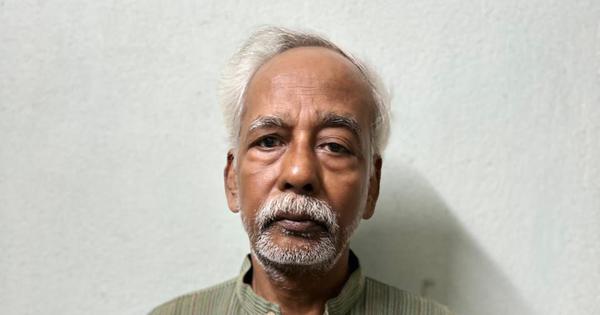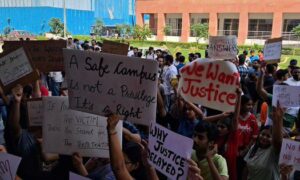
The Last Bench by the Bengali writer and publisher Adhir Biswas, translated from the Bengali by V Ramaswamy, gently yet radically unsettles the socio-economic spatiality we attach to the idea of the “last bench.” In many private school classrooms, we grow up seeing the last row as the space of indifference: the realm of so-called troublemakers, the mischievous, the disengaged. These backbenchers are often portrayed as either defiant or indifferent, performing a certain kind of adolescent coolness, unfazed by grades or teachers’ disapproval.
Casteism in the classroom
But Biswas, with clarity and brutal honesty, turns this dominant narrative on its head. Through a deeply personal retelling of his childhood, he reframes the last bench not as a position of indifference but as a position of exclusion – a spatial metaphor for caste, poverty, and invisibilised marginality. His memoir lays bare the everyday violence of caste and class that so often go unacknowledged in the national and dominant imagination of merit and education.
Ratan, the son of a barber who migrated with his family from erstwhile East Pakistan to India in 1976, looks back at his childhood in a lost homeland. His entry into school, ensured after much hardship and carried by a quiet hope for a better future through education, feels like a small victory. In those early days, Ratan wonders why his elder brother has dropped out. At the time, he cannot understand his decision, but soon, life will make the answer painfully clear.
The joy of being in school, the innocent excitement of learning, begins to wither under the weight of poverty, casual cruelties, exclusion and a deep sense of unbelonging. The violence he faces is not always loud, but it is constant. It comes in the form of hunger, humiliation, and the everyday exclusions rooted in caste. Education, which had once seemed like a possible way to escape this drudgery, becomes another terrain where caste marks him, isolates him, and eventually pushes him out – just like it did his brother.
The Last Bench takes the reader through Ratan’s world, where a little boy tries with all his might to make sense of the pain around him. He wonders why his mother is always ill and deeply sad, why his father is perpetually tired and seething with anger, and why his elder brother suddenly ran away from home. Through his sincere questions and confusion, Ratan unknowingly reveals the brutal, everyday assault of caste on his family.
In his childish curiosity, he asks why they are not allowed to use the village well, why no one wants to play with him, and why the other children from so-called upper castes believe it is acceptable to beat him mercilessly and leave him bleeding. He cannot understand why no one visits his father’s barber shop, or why his father takes out his anger on him while his mother watches in fear, worrying that he might one day go too far. The violence is everywhere, outside the home and within it and it seeps into Ratan’s young consciousness as a reality that he cannot always name or comprehend but can always deeply feel, following him like a shadow.
A space of isolation
Like the stench of poverty described by George Orwell in The Road to Wigan Pier, the visceral, lingering smell of the working-class slums, Ratan too finds himself marked and trapped by a similar smell. It clings to him, not just as a physical reality but as a social marker that others use to exclude and humiliate him. Because of that smell, Ratan is pushed to the last bench, ridiculed and shamed for things entirely beyond his control: his unwashed clothes, his scabbed skin, the pus in his ears, the scabies that made him itch through class.
The last bench, where he sat alone with his cracked slate and a damp rag to clean it, becomes more than just a physical space. It becomes a spectacle of the cruel performance of caste and class exclusion staged daily in the classroom. It is from this space of isolation and indignity that Ratan’s gradual departure from the world of education begins. The very system that once offered a slight hope ends up reinforcing his marginalisation until it finally pushes him out.
His only refuge in an otherwise hostile world was his ailing mother. Together, they would sometimes wander into the woods or to the edges of the village, finding fleeting moments of peace in each other’s quiet company. They saw the world through each other’s eyes, sharing a bond that tried to heal the cruelty of caste and poverty. After her death, Ratan found solace in another companion in Bhombol, the loyal dog who followed him like a shadow, offering silent companionship in a world that refused to see him.
The Last Bench is not just a memoir of a childhood shaped by exclusion; it is a deeply affecting meditation on what it means to grow up invisible in a society built on layers of inequality. It captures with aching clarity how caste seeps into the smallest corners of life – into classrooms, homes, friendships, language, and even dreams. Through Ratan’s eyes, we witness not just caste induced poverty, but the quiet devastation of being constantly made to feel lesser, unworthy, untouchable.
At its heart, this is also a story about loss, not only the grief of losing those whose presence once made life bearable, like his mother but also the grief of never having known a life untouched by violence and humiliation. It is a longing not for ease or privilege, but for a life where love isn’t marked by fear, where laughter isn’t interrupted by hunger, and where education doesn’t come with the price of erasure.
In telling his story, Adhir Biswas reminds us that caste is not an outdated relic, but a living wound, the one that festers in everyday silences, in beatings disguised as discipline, in absences that are never named. It is a wound that shapes who is allowed to belong, who is taught to aspire, and who is quietly pushed to the margins and forgotten. Yet through the act of remembering and writing, Biswas reclaims that forgotten child and, in doing so, refuses erasure.
The Last Bench, Adhir Biswas, translated from the Bengali by V Ramaswamy, Ekada/Westland.
This article first appeared on Scroll.in
📰 Crime Today News is proudly sponsored by DRYFRUIT & CO – A Brand by eFabby Global LLC
Design & Developed by Yes Mom Hosting






